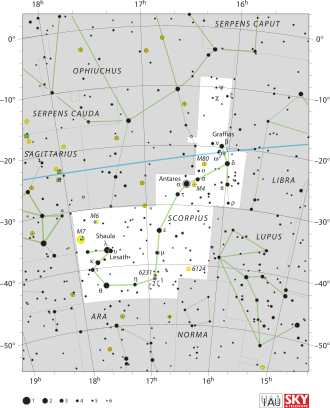| Observation data Epoch J2000 Equinox J2000 | |
|---|---|
| Constellation | Scorpius |
| Right ascension | 16h 31m 22.93300s [1] |
| Declination | −34° 42′ 15.7146″ [1] |
| Apparent magnitude (V) | 4.23 [2] |
| Characteristics | |
| Spectral type | B2 III-IV [3] |
| U−B color index | −0.76 [2] |
| B−V color index | −0.17 [2] |
| Variable type | candidate β Cephei [4] |
| Astrometry | |
| Radial velocity (Rv) | 0.8±1.5 [5] km/s |
| Proper motion (μ) | RA: −12.05±0.20 mas/yr [1] Dec.: −18.16±0.13 mas/yr [1] |
| Parallax (π) | 5.88±0.19 mas [1] |
| Distance | 550 ± 20 ly (170 ± 5 pc) |
| Absolute magnitude (MV) | −1.91 [6] |
| Details | |
| Mass | 7.8±0.1 [7] M☉ |
| Radius | 6.25 [8] R☉ |
| Luminosity (bolometric) | 6,918 [9] L☉ |
| Surface gravity (log g) | 4.0 [9] cgs |
| Temperature | 21,877 [9] K |
| Metallicity [Fe/H] | +0.01 [10] dex |
| Rotational velocity (v sin i) | 70±8 [11] km/s |
| Age | 22±4 [7] Myr |
| Other designations | |
| N Scorpii, 72 G. Scorpii [12] , CD−34°11044, CPD−34°6528, FK5 1431, GC 22195, HD 148703, HIP 80911, HR 6143, SAO 207732 [13] | |
| Database references | |
| SIMBAD | data |
N Scorpii, also known as HD 148703, is a solitary, [14] bluish-white hued star located in the southern constellation Scorpius. It has an apparent magnitude of 4.23, making it readily visible to the naked eye. N Scorpii was initially given the Bayer designation Alpha Normae by Lacaille but it was later moved from Norma to Scorpius. [15] N Scorpii is currently located 550 light years away based on parallax measurements from the Hipparcos satellite and is part of the Upper Scorpius–Centaurus region of the Scorpius–Centaurus association. [16]
N Scorpii has been given several stellar classifications over the years. It has been given the luminosity class of a main sequence star (V), [17] a subgiant (IV), [18] an evolved giant star (III), [19] or a blend between the last two classes (III-IV). [3] It is generally classified as either a B2 or B3 star several times hotter than the Sun. HD 148703 is a candidate β Cephei variable [4] and its variability was first noticed in 1983 by C. Sterken. [20] Further observations were made by Abt et al. (2002) by observing its projected rotational velocity. [21] It was identified as a candidate in 2002 in a survey for non-radial pulsations in B-type stars. [22]
The object has two generally accepted classes: B2 III-IV and B2 IV. It has 7.8 times the mass of the Sun [7] and 6.25 times its size. [8] It has a bolometric luminosity 6,918 times greater than the Sun from its photosphere at an effective temperature of 21,877 K . [9] N Scorpii is estimated to be 22 million years old, [7] which is twice the average age of the aforementioned association. Like most hot stars, N Scorpii spins rapidly, having a projected rotational velocity of 70 km/s . [11]
